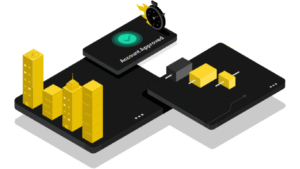The digital payment revolution continues to transform how businesses manage financial transactions worldwide. Modern payment management systems have transformed from basic card processors into sophisticated platforms that orchestrate complex payment workflows, security protocols, and customer experiences.
Organizations are discovering that their choice of a payment management system has a direct impact on customer satisfaction, operational efficiency, and revenue growth.
The acceleration toward digital-first payment solutions shows no signs of slowing. Businesses now demand a payment management system capable of handling diverse transaction types while maintaining seamless user experiences.
This evolution reflects fundamental shifts in consumer behavior and the competitive necessity for organizations to adapt their payment infrastructure.
Current Payment Infrastructure Landscape
A modern payment management system integrates cutting-edge technologies to deliver experiences that customers now consider standard expectations rather than luxury features.
Architecture of Modern Payment Systems
Contemporary payment management system design prioritizes flexibility and scalability above all else. These platforms utilize cloud-native architectures that automatically adjust to transaction volumes while maintaining consistent performance.
The underlying technology stack comprises sophisticated APIs that enable businesses to tailor payment flows to meet specific operational requirements.
Security measures have evolved to include multiple authentication layers, real-time monitoring, and advanced encryption protocols. The infrastructure supports global compliance requirements while adapting to regional regulatory variations.
Integration Capabilities and Business Operations
Today’s payment management system serves as a central hub connecting various business functions:
- Customer relationship management platforms
- Inventory management systems
- Accounting and financial reporting tools
- Marketing automation platforms
This connectivity creates unified ecosystems where payment data flows seamlessly across different organizational departments. Business leaders gain access to comprehensive analytics that inform strategic decisions about customer acquisition, pricing strategies, and market expansion opportunities.
The real-time nature of modern payment processing enables immediate transaction confirmations and instant settlement notifications.
Digital Payment Revolution Continues
Digital payment adoption has reached critical mass, with businesses recognizing the need to support multiple payment options to remain competitive.
Digital Wallet Dominance and Super App Integration
Digital wallets have become essential components of any comprehensive payment management system. These platforms offer one-click payment experiences that significantly reduce checkout friction and improve conversion rates. The technology enables secure credential storage while providing convenient access across multiple devices and platforms.
Super apps represent the next evolution in payment processing integration. These comprehensive platforms combine:
- Messaging and communication services
- Social media functionality
- E-commerce capabilities
- Financial services and payments
Payment management systems must adapt to support embedded payment functionality within these integrated environments.
Real-Time Payment Processing Revolution
Instant payment systems have gained significant traction as businesses seek faster access to funds and improved cash flow management. Real-time payment processing eliminates traditional batch processing delays, providing immediate transaction confirmation and settlement.
Account-to-account transfers offer compelling alternatives to traditional card networks by enabling direct bank-to-bank transactions. Also, there are cost advantages for high-value transactions and business-to-business payments.
The benefits of real-time payment processing extend beyond speed improvements:
- Enhanced cash flow predictability
- Reduced transaction uncertainty
- Improved customer satisfaction through instant confirmations
- Lower processing costs for certain transaction types
Artificial Intelligence Transforms Payment Processing
Machine learning and artificial intelligence have become integral components of modern payment management systems. These technologies enhance security, improve user experiences, and provide valuable business insights through advanced data analysis and analytics.
AI-Powered Fraud Detection and Security
Advanced fraud detection systems utilize machine learning algorithms to analyze transaction patterns and identify potentially suspicious activities. These systems learn from historical data to improve accuracy over time while reducing false positive rates that can frustrate legitimate customers.
Real-time risk assessment capabilities enable payment systems to make split-second decisions about transaction authorization. The technology considers multiple factors, including transaction history, device fingerprinting, behavioral patterns, and geographic location, to accurately assess risk levels.
Personalization Through Machine Learning
Payment management systems now leverage artificial intelligence to optimize customer experiences by presenting personalized payment options. Machine learning algorithms analyze individual customer preferences, transaction history, and behavioral patterns to recommend optimal payment methods during checkout.
This personalization extends to:
- Dynamic payment method ordering based on customer preferences
- Customized checkout flow optimization
- Intelligent payment retry logic for failed transactions
- Personalized promotional offers and incentives
The result is improved conversion rates and reduced cart abandonment through more relevant and convenient payment experiences.
Alternative Payment Methods Gain Momentum
The expansion of payment options beyond traditional credit and debit cards has accelerated significantly. Modern payment management systems must accommodate diverse payment preferences while maintaining security and operational efficiency.
Buy Now, Pay Later Integration
BNPL services have evolved from niche offerings to mainstream payment options that businesses integrate directly into their checkout processes. These services allow customers to split purchases into manageable installments while providing merchants with immediate payment settlement.
The expansion of BNPL applications now includes:
- Traditional retail purchases
- Service-based transactions
- Travel and hospitality bookings
- Healthcare and medical services
- Educational and training programs
A payment management system requires a flexible architecture to support various BNPL terms, regulatory compliance requirements, and integration with multiple service providers.
QR Code Payment Evolution
QR code payments continue to evolve, incorporating enhanced security features and expanding into broader application scenarios. These contactless payment methods offer convenience for both online and offline transactions while maintaining strong security protocols.
Dynamic QR code generation includes transaction-specific security tokens that prevent fraud and ensure payment authenticity. Payment systems generate unique codes for each transaction, providing traceability and enhanced security compared to static QR implementations.
Emerging Technologies Shape Future Payments
The payment industry continues to explore innovative technologies that could fundamentally change how transactions are processed and experienced by customers.
Voice Commerce and Hands-Free Payments
Voice-activated payment systems represent an emerging frontier in payment processing technology. These systems prove particularly valuable for:
- Recurring subscription renewals
- Simple product reorders
- Service appointment bookings
- Quick balance inquiries and transfers
Voice payment technology requires sophisticated natural language processing and multi-factor authentication to ensure security while maintaining convenience.
Cryptocurrency and Digital Currency Integration
The integration of cryptocurrency payments into traditional payment management systems progresses as regulatory frameworks develop. Businesses prepare for broader digital currency adoption by updating their payment infrastructure to support various cryptocurrency options.
Central Bank Digital Currencies represent significant developments that payment systems must accommodate as governments explore the implementation of digital currencies. These government-backed digital currencies could provide new payment rails that complement existing infrastructure.
Security Enhancements and Risk Management
Modern payment security extends far beyond basic encryption to encompass comprehensive risk management strategies and advanced authentication methods.
Biometric Authentication Implementation
Biometric authentication technologies provide enhanced security without compromising user experience.
Common biometric authentication methods include:
- Fingerprint recognition for mobile payments
- Facial recognition for device-based authentication
- Voice verification for telephone transactions
- Retinal scanning for high-security applications
A payment management system integrates these authentication methods to provide layered security while maintaining a seamless user experience.
Advanced Encryption and Tokenization
Multi-layered security approaches protect sensitive payment data throughout the entire transaction lifecycle. Advanced encryption protocols ensure that payment information remains secure during transmission and storage.
Tokenization technology replaces sensitive payment data with unique tokens that have no value outside specific transaction contexts. This approach minimizes data breach risks while enabling payment processing functionality.
Strategic Business Impact and Implementation
The adoption of advanced payment systems creates measurable impacts on business performance and customer relationships.
Operational Efficiency and Customer Experience
Modern payment systems streamline business operations through automated reconciliation processes, real-time reporting capabilities, and integrated financial analytics, enabling more efficient management of financial transactions.
These features reduce manual processing requirements while providing actionable insights about payment performance and customer behavior.
Customer experience improvements include faster checkout processes, multiple payment option availability, and reduced transaction failures.
Regulatory Compliance and Risk Mitigation
Payment management systems must navigate increasingly complex regulatory requirements across different jurisdictions and industry sectors. Built-in compliance monitoring and reporting capabilities help businesses maintain regulatory adherence while minimizing operational burden.
Risk management features include real-time transaction monitoring, automated risk scoring systems, and customizable fraud prevention rules.
Implementation Strategy and Future Planning
Successful payment system implementation requires careful planning and consideration of both current needs and future growth requirements.
System Selection and Integration Planning
The chosen payment management system must align with business objectives while providing flexibility for future expansion.
Key evaluation criteria include:
- Scalability and performance capabilities
- Security and compliance features
- Integration and customization options
- Cost structure and pricing models
- Vendor support and reliability
Change Management and Training Requirements
Successful implementation extends beyond technical integration to encompass staff training and change management processes. Team members must understand new payment procedures, security protocols, and customer service approaches.
Proper implementation planning includes comprehensive testing phases, backup procedures, and performance monitoring systems to ensure smooth transitions from the existing payment infrastructure.
To Sum Up
The evolution of payment systems reflects the broader digital transformation occurring across industries worldwide. Organizations that invest in modern payment infrastructure position themselves to capitalize on emerging opportunities while meeting the evolving expectations of their customers.
The payment management system landscape of 2025 and beyond will offer unprecedented capabilities in terms of processing speed, security protocols, and customer experience optimization.
Article received in the mail































